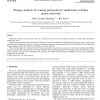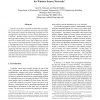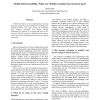362 search results - page 7 / 73 » Separation principles in wireless networking |
COMCOM
2008
13 years 7 months ago
2008
Underwater wireless sensor networks consist of a certain number of sensors and vehicles that interact to collect data and perform collaborative tasks. Designing energy-efficient r...
ICDCSW
2005
IEEE
14 years 1 months ago
2005
IEEE
Internet worms have repeatedly revealed the susceptibility of network hosts to malicious intrusions. Recent studies have proposed to employ the underlying principles of worm propa...
HICSS
2002
IEEE
14 years 12 days ago
2002
IEEE
In this paper we discuss the mechanism of multipoint relays (MPRs) to efficiently do the flooding of broadcast messages in the mobile wireless networks. Multipoint relaying is a...
INFOCOM
2008
IEEE
14 years 1 months ago
2008
IEEE
Abstract—In this paper, we advocate asymmetric function placement as one of guiding principles to architect sensor network systems. We demonstrate its generic applicability and e...
WMTE
2002
IEEE
14 years 11 days ago
2002
IEEE
‘Mobile Learning’ is a type of application/service that generally presumes to use mobile Internet technology for learning purposes. This paper focuses on discussing basic usab...



